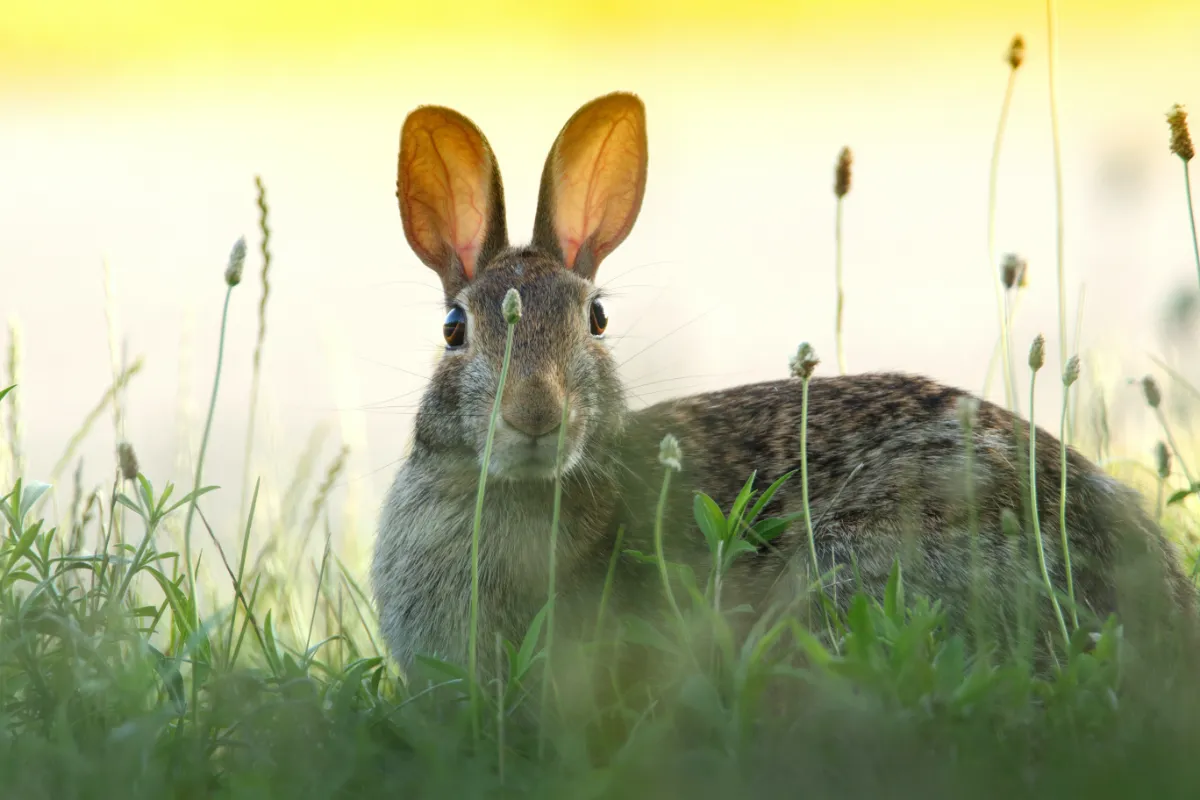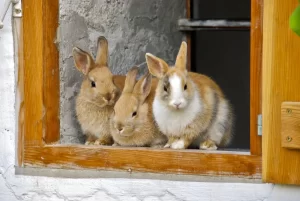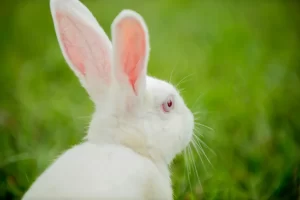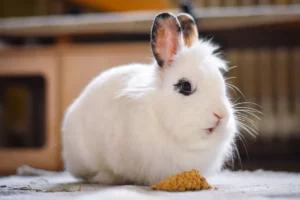Do you ever wonder how rabbits perceive you?
Step into the fascinating world of rabbit vision as we explore how these adorable creatures see humans.
Discover the intricate anatomy of their eyes, their ability to perceive colors, depth, and spatial awareness.
Learn how rabbits interpret your body language and whether they can recognize you as an individual.
By understanding their visual communication, you’ll gain a deeper appreciation for the unique way rabbits see the world around them.
In This Article
- 1 Key Takeaways
- 2 The Visual Spectrum of Rabbits
- 3 Rabbit Eye Anatomy and Structure
- 4 Color Perception in Rabbits
- 5 Depth Perception and Spatial Awareness
- 6 Recognizing Human Faces and Features
- 7 How Rabbits Interpret Body Language
- 8 Do Rabbits Recognize Individual Humans
- 9 Understanding Rabbits’ Visual Communication
- 10 Frequently Asked Questions
- 10.1 Can Rabbits See in the Dark?
- 10.2 Do Rabbits Have Better Color Vision Than Humans?
- 10.3 How Do Rabbits Perceive Objects That Are Far Away?
- 10.4 Can Rabbits Distinguish Between Different Human Facial Expressions?
- 10.5 Do Rabbits Rely More on Visual Cues or Body Language When Interacting With Humans?
- 11 Conclusion
Key Takeaways
- Rabbits have a form of facial recognition and can differentiate between familiar and unfamiliar humans.
- Scent plays a crucial role in rabbit-human interactions and recognition.
- Visual communication, including subtle movements, body language, and eye contact, is important for understanding rabbits’ emotions and intentions.
- Building trust and establishing a strong bond with rabbits involves consistent interaction, positive reinforcement, and understanding their social needs.
The Visual Spectrum of Rabbits
You should regularly observe the visual spectrum of rabbits to understand their color perception. Rabbits have a unique ability to perceive ultraviolet light, which is invisible to the human eye. This means that they can see a wider range of colors than we can. Their ultraviolet perception allows them to detect subtle differences in shades and patterns, which is especially useful for survival in their natural habitat.
Additionally, rabbits have excellent visual acuity, meaning they can see fine details with precision. This is important for their foraging behavior and predator detection.
Rabbit Eye Anatomy and Structure
It’s fascinating to learn about how a rabbit’s eye anatomy and structure contribute to its unique visual abilities. Rabbits have evolved to have certain features in their eyes that allow them to navigate their environment and detect predators or prey. Understanding the function and health of a rabbit’s eyes is crucial for those who desire to serve these furry creatures. Here are some key points to consider:
- Rabbits possess a wide field of vision, allowing them to detect potential threats from various angles.
- Their eyes are positioned on the sides of their head, providing them with a panoramic view of their surroundings.
- Rabbits have a high sensitivity to motion, enabling them to quickly spot any movement in their environment.
- Their eyes have a specialized structure called a tapetum lucidum, which enhances their ability to see in low-light conditions.
Color Perception in Rabbits
Can rabbits see color, or is their vision limited to shades of gray? Rabbits have evolved unique visual adaptations that allow them to perceive color to some extent. While their color vision isn’t as developed as humans’, they can distinguish certain colors, particularly those in the blue and green spectrum. This ability is due to the presence of specialized cone cells in their retinas, which are responsible for color perception.
However, rabbits have a lower visual acuity compared to humans, meaning their ability to see fine details is limited. Their vision is more suited for detecting movement and distinguishing shapes rather than discerning intricate details.
Understanding the evolutionary adaptations and visual acuity of rabbits helps us better comprehend their perception of the world, enabling us to provide appropriate care and ensure their well-being.
Depth Perception and Spatial Awareness
Pay attention to how rabbits navigate their surroundings, as their depth perception and spatial awareness are crucial for their survival.
Rabbits have excellent visual acuity, allowing them to detect even the slightest movements in their environment. Their eyes are positioned on the sides of their head, providing them with a wide field of view. However, rabbits lack binocular vision, which means they struggle with judging depth accurately.
Instead, they rely on other cues to estimate distances, such as motion parallax and the size of objects. This reliance on monocular cues may explain why rabbits have a tendency to freeze when approached by a potential predator.
They need to assess the threat and decide on the best course of action to ensure their survival.
Recognizing Human Faces and Features
Do you ever find yourself fascinated by the intricacies of recognizing human faces and features?
While humans are known for their ability to easily distinguish between different faces, did you know that rabbits also possess a form of facial recognition?
Facial recognition in rabbits is a complex process that involves the integration of visual and olfactory cues.
Rabbits have a keen sense of smell, and they rely on scent to identify individuals, both humans and fellow rabbits.
In fact, scent plays a crucial role in rabbit-human interactions, as rabbits can recognize familiar individuals by their unique scent.
This ability allows rabbits to differentiate between friendly and unfamiliar humans, helping them navigate their social environment.
Understanding the importance of facial recognition and scent in rabbit-human interactions can greatly enhance our understanding of their behavior and improve our ability to provide appropriate care for these fascinating creatures.
How Rabbits Interpret Body Language
You should be aware that rabbits interpret body language through a combination of visual cues and instinctual understanding. When interacting with rabbits, it’s important to understand how they perceive your non-verbal cues. Here are some key points to keep in mind:
- Eye contact: Rabbits interpret direct eye contact as a sign of aggression. Avoid staring directly into their eyes, as this can make them feel threatened or uncomfortable.
- Body posture: A relaxed and open posture can help rabbits feel at ease. Avoid sudden movements or looming over them, as this can be perceived as a threat.
- Tone of voice: Rabbits are sensitive to the tone of your voice. Speak softly and gently to create a calm and reassuring environment.
- Facial expressions: Rabbits can pick up on subtle changes in facial expressions. Smiling or gently closing your eyes can convey a sense of safety and trust.
Understanding these non-verbal cues in rabbit-human interactions can help foster a positive and respectful relationship with your furry friends.
Do Rabbits Recognize Individual Humans
Keep in mind that rabbits can recognize individual humans based on their scent and appearance. Rabbit behavior is complex and involves various social interactions.
Rabbits have a keen sense of smell, which allows them to identify different individuals based on their unique scent. They can also recognize humans by their appearance, such as recognizing their facial features or the way they move.
This ability to recognize individual humans is an important aspect of rabbit behavior, as it helps them establish trust and familiarity with their human caregivers. Building a bond with a rabbit requires consistent interaction, positive reinforcement, and understanding their social needs.
Understanding Rabbits’ Visual Communication
Pay attention to the subtle movements and body language of rabbits, for they can convey a lot of information through their visual communication. Rabbits, like many animals, rely on nonverbal cues to express their emotions and intentions. Understanding their visual communication is crucial in providing them with the care they need.
Here are some key aspects to consider:
- Ear position: When a rabbit’s ears are relaxed and facing forward, it indicates that they’re feeling calm and content. If their ears are flattened against their back, it suggests they’re scared or agitated.
- Body posture: A relaxed and stretched out body posture suggests that a rabbit is comfortable and at ease. On the other hand, if they’re crouched down with their body tense, it may mean they feel threatened or anxious.
- Tail movements: A rabbit’s tail can give insight into their emotional state. A raised and twitching tail indicates excitement, while a tucked and still tail suggests fear or uneasiness.
- Eye contact: Direct eye contact can be seen as a sign of aggression or dominance among rabbits. Avoid prolonged eye contact to prevent any potential conflicts.
Frequently Asked Questions
Can Rabbits See in the Dark?
Rabbits have excellent night vision, allowing them to navigate in low light conditions. While they can see in the dark, it’s important to note that they still need some light to see clearly.
Do Rabbits Have Better Color Vision Than Humans?
Rabbits have superior color vision compared to humans. Their visual acuity allows them to perceive a wide range of colors, enhancing their perception of humans. It’s fascinating how animals perceive the world differently!
How Do Rabbits Perceive Objects That Are Far Away?
When perceiving objects at a distance, rabbits rely on their visual acuity and depth perception. Their eyes are adapted to detect movement and spot predators or prey from afar, allowing them to navigate their environment effectively.
Can Rabbits Distinguish Between Different Human Facial Expressions?
Rabbits, like humans, have the ability to recognize different facial expressions. They can distinguish between a smile and a frown, and their emotional response may vary depending on the expression they see.
Do Rabbits Rely More on Visual Cues or Body Language When Interacting With Humans?
Rabbits rely more on visual cues than body language when interacting with humans. Understanding nonverbal cues is essential for effective communication. They prefer clear and consistent signals to feel safe and secure in their interactions with you.
Conclusion
In conclusion, rabbits possess a unique visual perception that allows them to see humans in a distinct way. Their eyes, specifically designed for survival in their natural environment, enable them to perceive colors, judge distances, and recognize human faces and body language.
While they may not fully comprehend individual humans, their visual communication skills help them navigate their surroundings and interact with their environment in a precise and informative manner.





